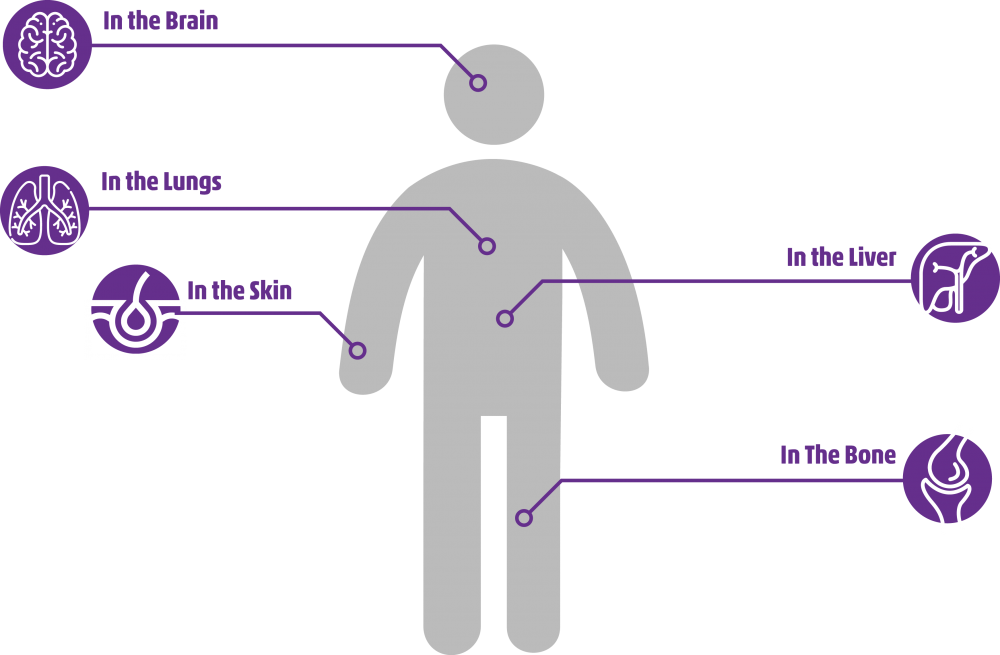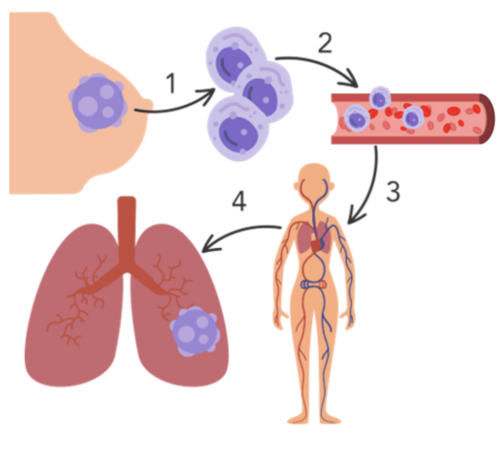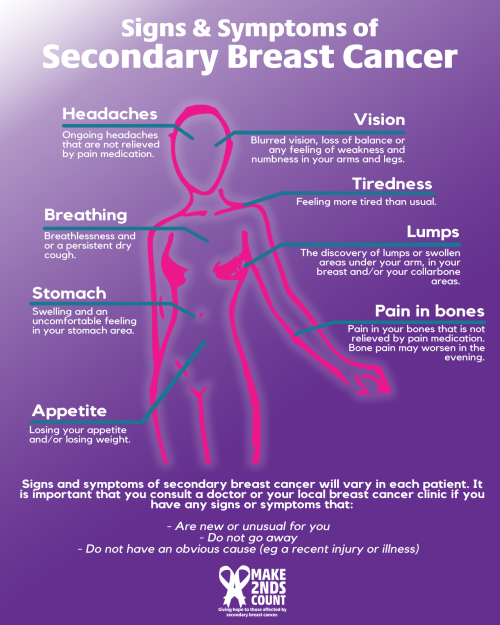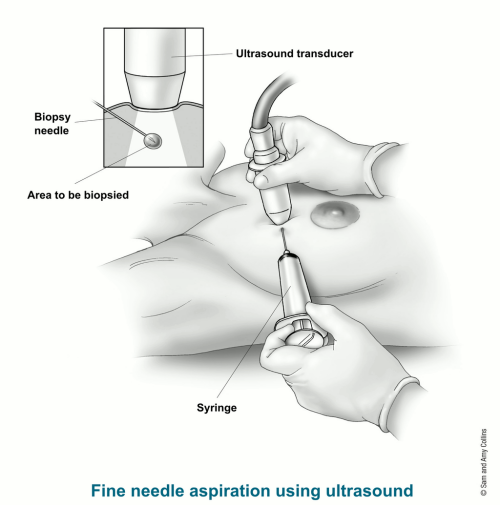About Secondary Breast Cancer
Secondary (metastatic) breast cancer is cancer that has started in the breast and spread to other parts of the body. This diagram shows common places where it may spread.

Click here for more information about sites of secondary breast cancer.
CONTENTS
What is secondary breast cancer?
Secondary breast cancer can also be known as:
-
metastatic breast cancer
-
advanced breast cancer
-
stage 4 breast cancer
The breast cancer cells can spread to other parts of the body through the bloodstream or lymphatic system. This process of spread is called metastasis and involves the following steps:

- The cancer cells break away from the primary tumour site and invade the nearby normal tissue.
- The cancer cells enter the blood or lymphatic system.
- The cancer cells travel through the blood or lymphatic vessels until they reach the target site, such as the bones, lungs, liver, brain etc.
- Once at the target site, the cancer cells leave the blood or lymphatic vessels and start to grow, forming secondary tumours.
Secondary breast cancer can be treated but it cannot be cured. Treatments aim to control and and slow the spread of the cancer for as long as possible, whilst giving the patient the highest quality of life.
Secondary breast cancer may be diagnosed years after primary breast cancer. Nearly 30% of women diagnosed with early-stage breast cancer will see their disease spread to other organs and develop secondary breast cancer. However, at first diagnosis some people can already have secondary breast cancer. This is classified as being diagnosed ‘de novo’.
A recent research estimate from NHS England data estimates that the number of patients living with secondary breast cancer in England was over 57,000 in 2021. The findings of this study showed that estimates for the number of secondary breast cancer patients have increased steadily and risen from 38,350 patients in 2016-2017.
These are estimates because cases of secondary breast cancer are not currently counted separately to primary breast cancer in the UK until death. Hopefully this will change as people living with secondary breast cancer are being counted for the first time, with national audits underway in England, Wales and Northern Ireland, with calls for Scotland to follow suit.
Signs and symptoms
The signs and symptoms of secondary breast cancer will vary in each individual. Usually, the signs and symptoms will depend on where the cancer has spread to in the body. It is important that you consult a doctor or your local breast cancer clinic if you have any signs or symptoms that:
-
Are new or unusual for you
-
Do not go away
-
Do not have an obvious cause (e.g. a recent injury or illness)
To find out more information about common signs and symptoms, visit the signs and symptoms page on our website.

Diagnosis
How is secondary breast cancer diagnosed?
There are three main ways secondary breast cancer can be diagnosed. This includes imaging, biopsies and genetic/genomic profiling.
Imaging
Imaging is a medical technique which tests to see if the cancer has spread. The most common imaging techniques include X-Rays, Ultrasounds and MRI Scans. These tests are helpful for your clinical team to understand how far and where the cancer has spread. This can help identify the best treatments and for you to understand your symptoms.
For more information on imaging visit the types of scans page.
Biopsies
A biopsy is when a small sample of tissue is taken from the secondary tumour and looked at under a microscope. A tumour biopsy helps your care team to understand characteristics of the secondary breast cancer.
Why do I need a biopsy?
In secondary breast cancer, tumour biopsies are done to check if the features of the cancer have changed since the primary diagnosis. The cancer cells in the secondary tumour may have different features compared to the primary tumour, such as human epidermal growth factor receptor 2 (HER2) and the hormone receptors (HR) oestrogen (ER) and progesterone (PR) present on the cell surface. This is important information as treatment decisions based on the receptors of the primary breast cancer may not always be suitable for the treatment of the secondary breast cancer.
Owise's blog; ‘Your Pathology Results Explained’ can help you better understand the pathology results from a biopsy.
Types of Biopsies
Tissue Biopsy (sometimes referred to as Needle Biopsy)
 A tissue biopsy is when a small sample of tissue is taken from the secondary tumour and looked at under the microscope. This can be taken from many parts of the body, including lymph nodes, lungs, liver, bone, skin and bodily fluids. Tissue biopsies are done using a needle which is inserted through the skin and into the part of the body being examined. This needle will then cut out a very small sample of tissue. During this process, local anaesthetic is used to minimise any pain or discomfort. The area may bleed a little after the biopsy, so you will usually be provided with a small plaster or dressing afterwards.
A tissue biopsy is when a small sample of tissue is taken from the secondary tumour and looked at under the microscope. This can be taken from many parts of the body, including lymph nodes, lungs, liver, bone, skin and bodily fluids. Tissue biopsies are done using a needle which is inserted through the skin and into the part of the body being examined. This needle will then cut out a very small sample of tissue. During this process, local anaesthetic is used to minimise any pain or discomfort. The area may bleed a little after the biopsy, so you will usually be provided with a small plaster or dressing afterwards.
Liquid Biopsy
Although tissue biopsies are more common, it is also possible to have a liquid biopsy. This involves taking a sample of bodily flood (e.g. blood, saliva) to detect and analyse cancer cells or cancer cells DNA. Liquid biopsies can find genetic mutations in cancer cells, see what treatments are suitable and monitor how well the treatment is working. They are useful when a tissue biopsy cannot be done or when quick results are needed. However, results from a liquid biopsy are often used along with tissue biopsy results to guide treatment decisions.
Genetic/Genomic Profiling
Genetic/genomic profiling is used to help understand the genetic information of an individual person or a specific cell type. Molecular testing on a biopsy sample can identify biomarkers. Biomarkers are genes, proteins or other substances which can be tested to find more information about a person’s cancer. This provides more information about what characteristics could be targeted with treatment.
How are genetic/genomic tests useful?
Tumour genomic tests can be used to measure the expression of certain genes in a biopsy sample. Measuring the expression of genes is useful to determine how likely a gene is to affect the behaviour of the cancer, including how likely it is to grow and spread.
For secondary breast cancer, genetic tests such as next generation sequencing (NGS) or sequencing panels are being developed. These tests can provide information about the weaknesses or vulnerabilities of the tumour. They can also help determine if certain changes in genes can make a person eligible for specific treatment. For example, a mutation in the PIK3CA gene could make a secondary HR+/HER2- patient eligible for treatment with alpelisib.
Treatments
There are many different treatment options for secondary breast cancer. The aim is to relieve symptoms and control/slow down the spread of cancer for as long as possible. This will hopefully allow people with secondary breast cancer the best quality of life. Treatment lines are determined by the oncology team with consideration of:
-
The type of breast cancer you have
-
How far it has spread and which part of the body it has spread to
-
What treatments you have had so far
-
How quickly your cancer is growing
-
Your general health
Treatment can include and can be a combination of:
-
Hormone therapy
-
Radiotherapy
-
Chemotherapy
-
Targeted biological therapies
For more information about types of treatment visit the treatments page.
Clinical trials may offer early access to new and improved treatments for secondary breast cancer. If you are interested to find out more about the options available through clinical trials, our dedicated team of nurses will be happy to support you.
See our Patient Trials Advocate Service and our clinical trials page for more information.
Living with secondary breast cancer
Getting a secondary breast cancer diagnosis can be mentally and physically gruelling for patients and those closest to them. In this section we have gathered together some resources to support you.
Having conversations with friends and family can be difficult. Here is a guide your loved ones may find helpful.
Patient Stories
There are many people living with secondary breast cancer who have shared their stories. These can be found on our Truth Be Told Page and the SBC and Me page. By reading about other people's stories, you may find similarities between other people's experiences and yours, this may put you at ease or grow a sense of community around you.
Life Expectancy
Life expectancy is difficult to predict as there are so many factors which can affect it. It can be dependent on subtype, how far the cancer has spread and the location(s) of spread.
However, with more research into new treatments, more people are living longer with a secondary breast cancer diagnosis.
Some people find it helpful to talk to their clinician for individual information about life expectancy. However, some prefer to not look at statistics or not to know.
It is important to know that there is no right way to live with secondary breast cancer and it’s ok to make your own path.
Support Available and Where to Find It
Make 2nds Count offers online support groups, virtual meet ups and classes: see the 2nds Together Facebook Group and Wellbeing Classes to find out more.
Our Tea & A Chat service offers a safe space for patients to meet and get peer to peer support in times of uncertainty. We also have a collection of online resources which may be helpful. To find groups and services available in your local area visit the 2nds Support Hub.
